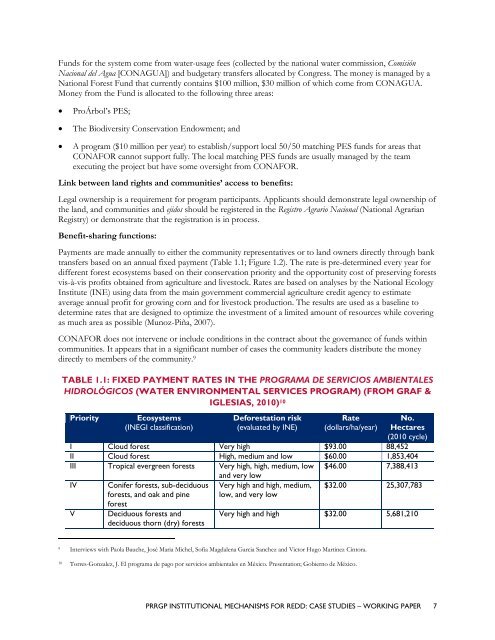Institutional Mechanisms for REDD+ - Case Studies Working Paper
Institutional Mechanisms for REDD+ - Case Studies Working Paper
Institutional Mechanisms for REDD+ - Case Studies Working Paper
Create successful ePaper yourself
Turn your PDF publications into a flip-book with our unique Google optimized e-Paper software.
Funds <strong>for</strong> the system come from water-usage fees (collected by the national water commission, Comisión<br />
Nacional del Agua [CONAGUA]) and budgetary transfers allocated by Congress. The money is managed by a<br />
National Forest Fund that currently contains $100 million, $30 million of which come from CONAGUA.<br />
Money from the Fund is allocated to the following three areas:<br />
� ProÁrbol‘s PES;<br />
� The Biodiversity Conservation Endowment; and<br />
� A program ($10 million per year) to establish/support local 50/50 matching PES funds <strong>for</strong> areas that<br />
CONAFOR cannot support fully. The local matching PES funds are usually managed by the team<br />
executing the project but have some oversight from CONAFOR.<br />
Link between land rights and communities’ access to benefits:<br />
Legal ownership is a requirement <strong>for</strong> program participants. Applicants should demonstrate legal ownership of<br />
the land, and communities and ejidos should be registered in the Registro Agrario Nacional (National Agrarian<br />
Registry) or demonstrate that the registration is in process.<br />
Benefit-sharing functions:<br />
Payments are made annually to either the community representatives or to land owners directly through bank<br />
transfers based on an annual fixed payment (Table 1.1; Figure 1.2). The rate is pre-determined every year <strong>for</strong><br />
different <strong>for</strong>est ecosystems based on their conservation priority and the opportunity cost of preserving <strong>for</strong>ests<br />
vis-à-vis profits obtained from agriculture and livestock. Rates are based on analyses by the National Ecology<br />
Institute (INE) using data from the main government commercial agriculture credit agency to estimate<br />
average annual profit <strong>for</strong> growing corn and <strong>for</strong> livestock production. The results are used as a baseline to<br />
determine rates that are designed to optimize the investment of a limited amount of resources while covering<br />
as much area as possible (Munoz-Piña, 2007).<br />
CONAFOR does not intervene or include conditions in the contract about the governance of funds within<br />
communities. It appears that in a significant number of cases the community leaders distribute the money<br />
directly to members of the community. 9<br />
TABLE 1.1: FIXED PAYMENT RATES IN THE PROGRAMA DE SERVICIOS AMBIENTALES<br />
HIDROLÓGICOS (WATER ENVIRONMENTAL SERVICES PROGRAM) (FROM GRAF &<br />
IGLESIAS, 2010) 10<br />
Priority Ecosystems<br />
(INEGI classification)<br />
De<strong>for</strong>estation risk<br />
(evaluated by INE)<br />
Rate<br />
(dollars/ha/year)<br />
No.<br />
Hectares<br />
(2010 cycle)<br />
I Cloud <strong>for</strong>est Very high $93.00 88,452<br />
II Cloud <strong>for</strong>est High, medium and low $60.00 1,853,404<br />
III Tropical evergreen <strong>for</strong>ests Very high, high, medium, low<br />
and very low<br />
$46.00 7,388,413<br />
IV Conifer <strong>for</strong>ests, sub-deciduous Very high and high, medium, $32.00 25,307,783<br />
<strong>for</strong>ests, and oak and pine<br />
<strong>for</strong>est<br />
low, and very low<br />
V Deciduous <strong>for</strong>ests and<br />
deciduous thorn (dry) <strong>for</strong>ests<br />
Very high and high $32.00 5,681,210<br />
9 Interviews with Paola Bauche, José Maria Michel, Sofia Magdalena Garcia Sanchez and Victor Hugo Martinez Cíntora.<br />
10 Torres-Gonzalez, J. El programa de pago por servicios ambientales en México. Presentation; Gobierno de México.<br />
PRRGP INSTITUTIONAL MECHANISMS FOR REDD: CASE STUDIES – WORKING PAPER 7

















